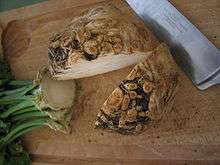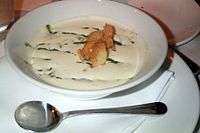Celeriac
| Apium graveolens var. rapaceum | |
|---|---|
 | |
| A celeriac hypocotyl sliced in half, and with the greens removed | |
| Scientific classification | |
| Kingdom: | Plantae |
| (unranked): | Angiosperms |
| (unranked): | Eudicots |
| (unranked): | Asterids |
| Order: | Apiales |
| Family: | Apiaceae |
| Genus: | Apium |
| Species: | A. graveolens |
| Variety: | rapaceum |
| Cultivars[1][2] | |
| |
Celeriac (Apium graveolens var. rapaceum), also called turnip-rooted celery[3] or knob celery, is a variety of celery cultivated for its edible roots, hypocotyl, and shoots. It is sometimes called celery root.[4]
It was mentioned in Homer's Odyssey as selinon.[5]
Celeriac is a root vegetable with a bulbous hypocotyl. In the Mediterranean Basin and in Northern Europe, celeriac grows wild and is widely cultivated.[2][3] It is also cultivated in North Africa, Siberia, Southwest Asia, and North America.[2] In North America, the Diamant cultivar predominates.[6] Celeriac originated in the Mediterranean Basin.[2]
Culinary use
Typically, celeriac is harvested when its hypocotyl is 10–14 cm in diameter.[6] However, a growing trend (specifically in Peruvian and South American cuisine) is to use the immature vegetable, valued for its intensity of flavour and tenderness overall. It is edible raw or cooked, and tastes similar to the stalks (the upper part of the stem) of common celery cultivars. Celeriac may be roasted, stewed, blanched, or mashed. Sliced celeriac occurs as an ingredient in soups, casseroles, and other savory dishes. The leaves and stems of the vegetable are quite flavoursome, and aesthetically delicate and vibrant, which has led to their use as a garnish in contemporary fine dining.
The shelf life of celeriac is approximately six to eight months if stored between 0 °C (32 °F) and 5 °C (41 °F), and not allowed to dry out.[7] However, the vegetable will tend to rot through the centre if the finer stems surrounding the base are left attached. The freshness of the vegetable can be determined by viewing the hollowness of the vegetable; a fresh celeriac should not have a hollow centre.[7] The freshness of the vegetable will also be obvious from the taste; the older the vegetable, the less potent the celery flavour.
See also
References
- ↑ "Growing Crops: Celery and Celeriac". Urban Organic Gardening. 17 June 2011. Retrieved 28 January 2012.
- 1 2 3 4 Schuchert, Wolfgang. "Celeriac (Apium graveolens L. var. rapaceum)". Crop Exhibition. Max Planck Institute for Plant Breeding Research. Retrieved 28 January 2012.
- 1 2
 Chisholm, Hugh, ed. (1911). "Celery". Encyclopædia Britannica. 5 (11th ed.). Cambridge University Press. p. 500.
Chisholm, Hugh, ed. (1911). "Celery". Encyclopædia Britannica. 5 (11th ed.). Cambridge University Press. p. 500. - ↑ Watson, Molly. "All About Celery Root (Celeriac)". localfoods.about.com. Retrieved 29 April 2014.
- ↑ "eat celery root". eattheseasons.com. 2010. Retrieved 29 April 2014.
- 1 2 "Celeriac (Apium graveolens rapaceum)". Desirable Vegetable Varieties, By Vegetable. The Owlcroft Company. Retrieved 28 January 2012.
- 1 2 "Small-scale postharvest handling practices - A manual for horticultural crops - 3rd edition". FAO Agriculture and Consumer protection. March 1995. Retrieved 29 April 2014.
External links
- Nutritional Summary for Celeriac, cooked, boiled, drained, without salt
- "RHS Award of Garden Merit: Asparagus, celeriac, chard, Chinese cabbage, fennel, melon, pak choi, rhubarb 2011". (306 KB)
